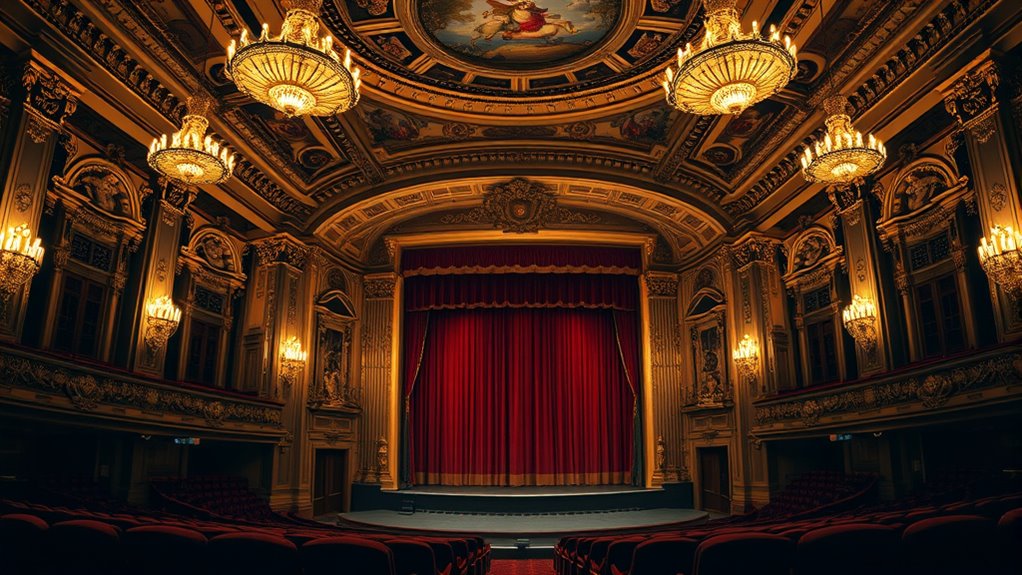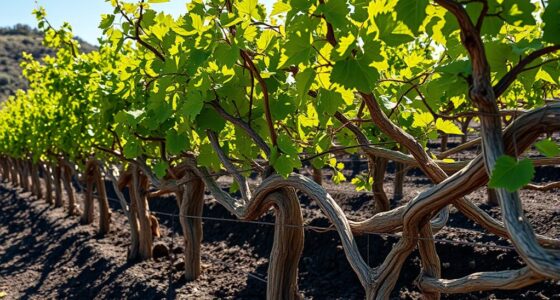Italian opera originates from the expressive ideals of the Renaissance and Baroque periods, focusing on storytelling through music and emotion. Early operas emphasized lyrical melodies and human drama, while Baroque innovations introduced new harmony, vocal techniques, and stage effects. These elements created a powerful, emotionally driven art form that has influenced global music culture. If you keep exploring, you’ll discover how these roots continue to shape opera’s enduring worldwide popularity and artistic legacy.
Key Takeaways
- Italian opera originated during the Renaissance, emphasizing human emotion, lyrical storytelling, and poetic integration.
- Baroque innovations introduced new harmony, ornamentation, and vocal techniques, enhancing expressive capabilities.
- Early operas built on Renaissance ideals, blending music and poetry to craft emotionally compelling narratives.
- The genre’s focus on individual virtuosity and dramatic expression shaped its global influence and enduring popularity.
- Italian opera’s foundational principles and innovations continue to inspire operatic art worldwide today.

Italian opera, a vibrant and influential art form, has its roots deeply embedded in the cultural and musical developments of the late Renaissance and early Baroque periods. During this time, you can see how Renaissance influences laid the groundwork for the genre’s expressive qualities. The Renaissance emphasized human emotion, lyrical melodies, and a focus on storytelling through music, all of which you’ll find echoed in the early operas. These foundational elements helped shape the dramatic and emotional depth that would become hallmarks of Italian opera. As you explore its origins, you’ll notice how composers and librettists drew inspiration from Renaissance ideals, blending poetry and music to craft compelling narratives.
Italian opera’s roots lie in Renaissance emphasis on emotion, lyrical melodies, and storytelling through music.
Moving into the Baroque period, you’ll observe how Baroque innovations transformed Italian opera. This era introduced new approaches to harmony, ornamentation, and vocal technique, making the opera more vibrant and emotionally engaging. You might notice the emergence of basso continuo, a continuous bass line that provided harmonic support and allowed performers to improvise embellishments, adding an expressive layer to performances. The use of contrast, such as between solo arias and choruses, became more pronounced, emphasizing individual emotion and drama. These innovations also led to the development of more elaborate stage effects and scenic design, enhancing the theatrical experience. The baroque spirit of experimentation encouraged composers to push boundaries, resulting in more dynamic, expressive operas that captivated audiences.
You’ll find that these Baroque innovations built upon Renaissance influences but also marked a departure, emphasizing individual virtuosity and emotional intensity. The fusion of the two periods created a unique aesthetic where lyrical melodies and dramatic expression worked hand-in-hand. As you explore more deeply, you’ll see how this evolution laid the foundation for the grand operatic traditions that followed. Composers like Monteverdi and later, Handel, took these elements further, refining the art form into a spectacle of music, drama, and visual storytelling. Their work exemplifies how the early Renaissance’s focus on human emotion and storytelling was expanded through Baroque innovations into a fully realized genre.
Understanding these roots helps you appreciate why Italian opera became a global phenomenon. It’s not just about the music; it’s about a cultural dialogue that began centuries ago, blending influences and innovations to create something truly timeless. The legacy of Renaissance influences combined with Baroque innovations continues to resonate, influencing opera today and inspiring audiences worldwide.
Frequently Asked Questions
How Did Italian Opera Influence Other Musical Genres Worldwide?
Italian opera influences other musical genres worldwide by blending folk traditions with theatrical storytelling, inspiring composers across genres. You’ll notice its impact in modern adaptations like musical theater, film scores, and even pop music, where expressive vocal techniques and dramatic elements are embraced. This fusion of folk roots and operatic grandeur shapes contemporary music, fostering innovation and cross-genre experimentation that continues to resonate globally.
What Role Did Political Factors Play in the Development of Italian Opera?
Political factors greatly shaped Italian opera’s development. You’ll find that censorship impacts often limited what composers could express, pushing them to innovate within constraints. Meanwhile, royal patronage played a vital role, providing financial support and prestige, which helped opera flourish. These political influences created a dynamic environment where artists navigated restrictions while gaining opportunities through noble sponsorship, ultimately shaping the rich, expressive art form that Italian opera is today.
Which Italian Composers Were Most Pivotal in Shaping Opera’s Evolution?
You’ll find that Italian composers like Monteverdi, Verdi, and Puccini shaped opera’s evolution more than you’d expect. Baroque masters like Monteverdi pushed boundaries, while contemporary innovators like Verdi and Puccini transformed storytelling with vivid emotion. Ironically, these giants built on each other’s work, blending tradition and innovation—proving that Italy’s musical giants kept opera alive, evolving it into a global phenomenon you still enjoy today.
How Did Italian Opera Evolve During the Romantic Period?
During the Romantic period, Italian opera evolved by emphasizing expressive vocal techniques that conveyed deep emotion and passion. You’ll notice more elaborate stage design, creating immersive worlds that heighten the dramatic impact. Composers like Verdi and Puccini pushed boundaries, blending powerful voices with stunning visuals. This combination made performances more emotionally engaging, shaping the future of opera worldwide and ensuring Italy’s influence remained strong in the genre.
What Are Some Lesser-Known Regional Styles Within Italian Opera History?
You might think Italian opera is all about the big names and famous regions, but hidden gems like the Neapolitan and Venetian styles hold secrets of regional dialects and local traditions. These lesser-known styles offer unique melodies and storytelling techniques that can surprise and delight you. They reveal a rich tapestry of cultural diversity, showing how Italy’s regional voices contribute deeply to the opera’s soul—waiting to be discovered and appreciated.
Conclusion
As you explore Italian opera’s roots, you begin to see it as a vibrant tree whose branches stretch across the world’s cultural landscape. Its melodies and stories continue to inspire, shaping countless musical traditions. Just like a mighty oak stands tall through storms, Italian opera’s influence endures, growing stronger with each generation. Embrace this rich history, and you’ll discover how its roots still shape the art form you cherish today.









